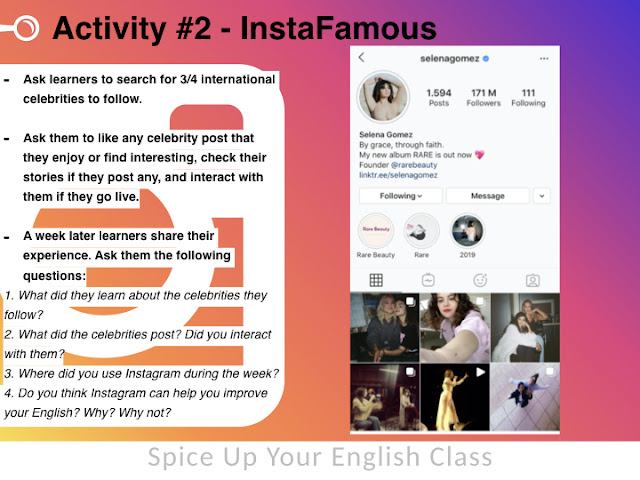Hi everyone!
Another week has just gone by and here I am again to share a teaching activity I carried out with a group of my students with you.
I'd like to start this post with a quote by one of my favourite writers.
 |
| www.google.com |
Creativity is one of the four 21st skills (along with critical thinking, collaboration, and communication) that students need to have in order to succeed. Moreover, according to Bloom's Taxonomy of Cognitive Development creativity is considered one of the higher-order thinking skills (HOTS). In particular it is defined as the ability to put parts together to create something new and unique by giving major emphasis on the formulation of new patterns or structures. (If you'd like to read more about Bloom's Taxonomy, I suggest that you visit this
webpage).
What I decided to do was to collect some of the definitions of 'creativity' which are true for me. I printed out a poster and put it on the wall of the room where I usually plan my lessons. I came up with the idea I'm sharing with you in the paragraph below while I was staring at it one day when my mind had gone blank.
CREATIVE CAFES
Level: B1 - upwards
Time: 2 hours
Linguistic Skills: Speaking, Listening, Writing
Soft Skills: Creative thinking, Problem Solving
Warm-up activity
I showed my Ls this picture, I told them it was the sign of a shop and they brainstormed ideas about which type of business it could be and then I asked them, 'What is special about this cafe?'
 |
| www.google.com |
In order to check their answers, Ls watched this
video up to 00:35. Some of my Ls were really surprised about this business model and one of them even said that it was not worth it since anyone can eat everything up.
Listening activity - Running 'question' dictation
In order to improve my Ls' listening skills without making some of them stressed about it I decided to carry out a peer-learning activity. Instead of giving them the comprehension questions I wrote them on post-it notes and put them on the classroom walls. Ls were divided in groups of four, but only one member could stand up and read the questions on the walls (of course everyone had a go) and then report them to the other members of their groups.
Ls watched the video till the end twice and then answered the questions.
These are the questions they had to answer.
1) What's the English word for Ziferblat?
2) Is the owner disappointed about people eating a lot?
3) Why do customers enjoy going to this cafe?
4) What's the shortest time someone spent at Ziferblat?
5) What's the longest time someone spent at Ziferblat?
6) What's the feedback the owner gives about his own experience?
Creative activity
Ls had to create their own business idea about a special cafe.
What's the name of the place?
What's special about it?
What are special features about its interior design?
What's its sign like?
By working in groups, I had the opportunity to monitor them better. Lots of new language came up and everyone was engaged in the task.
Plus, what I loved about the classroom setting was that I could challenge them with possible problems they could have in their businesses and ask them to think about how they might solve them.
For example, one of the cafes, 'The Dice Cafe' gave the chance to their customers to pay half price for their coffees if they rolled a dice and got 6. I asked them, 'What if the customer were a gambler, s/he wanted to roll the dice again and an argument arouse?' They discussed about it and then decided to hire a bouncer.
Also, two groups chose the same name, 'Once upon a cafe', for their businesses. I asked them to explained their cafes to the other groups who had to decide which group was going to keep the name.
Here you are some creative cafes my Ls were working on.
When they finished, they presented their ideas to the class.

Through a blinding voting operation :), they decided which idea we were going to upload in a crowdfunding website such as https://www.indiegogo.com.
That's all for now, folks!
 ▶️When students are assigned different tasks, they are not concerned about the task itself but the
▶️When students are assigned different tasks, they are not concerned about the task itself but the 




























